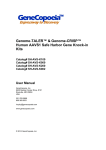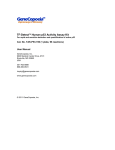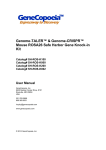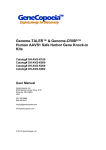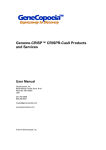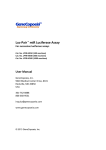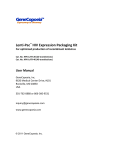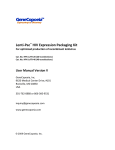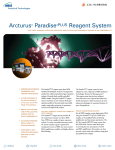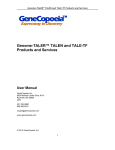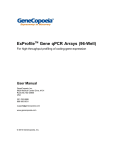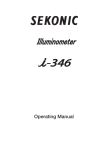Download Secrete-PairTM Dual Luminescence Assay Kit
Transcript
eneCopoeia G Expressway to Discovery TM Secrete-PairTM Dual Luminescence Assay Kit For parallel bioluminescence assays of Gaussia luciferase (GLuc) and secreted Alkaline Phosphatase (SEAP) Cat. No. SPDA-D010 (100 reactions) Cat. No. SPDA-D030 (300 reactions) Cat. No. SPDA-D100 (1000 reactions) Secrete-PairTM Gaussia Luciferase Assay Kit For stable and sensitive assay of Gaussia luciferase activity Cat. No. SPGA-G010 (100 reactions) Cat. No. SPGA-G100 (1000 reactions) User Manual GeneCopoeia, Inc. 9620 Medical Center Drive, #101 Rockville, MD 20850 USA 301-762-0888 866-360-9531 [email protected] www.genecopoeia.com © 2013 GeneCopoeia, Inc. Secrete-Pair™ Luminescence Assay Kits User Manual USER MANUAL Secrete-Pair™ Dual Luminescence Assay Kit Secrete-Pair™ Gaussia Luciferase Assay Kit I. Introduction and Principle II. Contents and Storage III. Protocol Overview IV. Preparation V. GLuc Assay Procedure VI. SEAP Assay Procedure VII. Signal Normalization VIII. Important Note IX. References X. Limited Use License and Warranty I. Introduction and Principle Secrete-PairTM Dual Luminescence Assay Kit The Dual Luminescence Assay kit is designed to analyze the activities of Gaussia Luciferase (GLuc) and Secreted Alkaline Phosphatase (SEAP) using luminescent assays side-by-side from a single sample such as cell culture medium. Both GLuc and SEAP are secreted reporter proteins. Samples can be easily obtained from cell culture medium without lysis of the cells. TM This assay kit has been optimized using GeneCopoeia GLuc-ON Promoter Reporter Clones. Each promoter clone contains a ~1-1.5 kb insert, corresponding to the 5'-flanking sequence located approximately 1-1.5 kb upstream of Transcription Initiation Site of a specific human gene. This insert is placed upstream of the GLuc reporter gene. Since the putative cis-acting enhancer elements are expected to exist in the cloned promoter region, the luciferase activity observed during the reporter assay closely resembles the actual promoter regulation of these genes within human cells. A secondary reporter gene, SEAP, can be used for transfection normalization. SEAP is available either on the same vector of GLuc or on a separate vector. Secrete-PairTM Gaussia Luciferase Assay Kit The Gaussia Luciferase Assay kit is designed to analyze the activities of Gaussia Luciferase (GLuc) only. Secreted GLuc can be easily obtained from cell culture medium without lysis of the cells. Gaussia luciferase as the reporter gene has strong advantages 1 Gaussia luciferase (185 aa, 19.9 kDa) is the smallest luciferase . It catalyzes the oxidation of the substrate 2 coelenterazine in a reaction that produces light (480 nm) . Figure 1. The Photo-oxidation catalyzed by Gaussia Luciferase Haddock, S.H.D., McDougall, C.M. and Case, J.F. The Bioluminescence Web Page, http://lifesci.ucsb.edu/~biolum/ (created 1997; updated 2005). 1) Naturally secreted, GLuc can be easily collected from cell culture medium without lysis of the cells (> 95% 3 of GLuc is secreted ). Transfected cells can be kept alive for continuous study, such as time-course, different conditions or other down-stream analysis. Since the sample collection and activity assay only take minutes, the GLuc system enables high-throughput screening and also monitors real-time activities. 2 Secrete-Pair™ Luminescence Assay Kits User Manual 2) GLuc is also the brightest luciferase available, which generates over 1000-fold higher bioluminescent signal intensity, when compared to firefly and Renilla luciferases, making it a highly sensitive 2 transcription reporter . 3) GLuc is stable over a wide pH range and in the conditioned cell culture medium . 4) In vivo, GLuc can be detected in blood or urine making it a sensitive tool for real-time monitoring of in 4 vivo processes . 2,4 The advantages of Secrete-Pair assay kit 1) 2) 3) 4) 5) 6) No cell lysis Secreted GLuc and SEAP Dual-reporter detection Detects GLuc and SEAP Enables transfection-normalization for accurate cross-sample comparison Highly sensitive and low background GLuc is the brightest luciferase and 1000-fold more sensitive than firefly or Renilla luciferases Easy to eliminate pre-accumulated GLuc by changing culture medium Real-time study The data is generated quickly and closely resembles real-time activities Robust and flexible conditions Two robust buffer conditions are provided for GLuc assays depending on the applications Buffer for stable activity retains more than 90% of signal within the first 10 minutes and extends the half-life of light emission to approximately 30 minutes Buffer for higher sensitivity can be used to detect low GLuc expression High-throughput compatible Quick and easy assay format High sample number compatible Secrete-Pair vs. Competitor -GLuc signal stability comparison 100 GL-S (Secrete-Pair) GL-H (Secrete-Pair) Competitor-S Competitor-H RLU/S (%) 80 60 40 20 0 0 5 10 15 20 25 30 35 40 Time (Min) Figure 2. Comparison of GLuc signal stability in different buffer systems from Secrete-Pair and a competitor Gaussia luciferase assay kit. Cell culture medium was collected from cells transfected with the humanized wild type GLuc reporter clones. 10 μl of the medium was used in each assay. Two buffer systems of each kit were tested and the assays were performed according to the manufacturer protocols. The percentage of signal retained (Y axis) is used as an indicator for signal stability. For both kits, the GLuc activities in buffers with a stabilizer (-S) are much more stable than those in buffers without a stabilizer (-H). However, when compared side-by-side, Secrete-Pair buffer systems provide more stable GLuc signal than the competitor kit. More than 90% of signal was retained within the first 10 minutes using GL-S buffer from Secrete-Pair (blue) and only about 70% of signal was retained using the competitor stable buffer (green). 3 Secrete-Pair™ Luminescence Assay Kits User Manual II. Contents and Storage Contents Quantity 100 reactions 300 reactions 1000 reactions Shipping temperature Storage temperature Secrete-Pair Kits Buffer GL-S (10X) GLuc buffer (For stable activity) 1 ml x 1 1 ml x 3 1.8 ml x 6 Dry ice or ice pack –20°C Stable for at least 6 months Dual luminescence assay kits Gaussia luciferase assay kits Buffer GL-H (10X) GLuc buffer (For high sensitivity) 1mx1 1 ml x 3 1.8 ml x 6 –20°C Stable for at least 6 months Dual luminescence assay kits Gaussia luciferase assay kits Substrate GL (100x) GLuc substrate 100 µl x 1 100 µl x 3 0.5 ml x 2 –20°C Stable for at least 6 months Dual luminescence assay kits Gaussia luciferase assay kits Buffer AP (10X)* SEAP buffer 1 ml x 1 1 ml x 3 1.8 ml x 6 Dry ice or ice pack –20°C Stable for at least 6 months Dual luminescence assay kits Substrate AP (100x)* SEAP substrate 100 µl x 1 100 µl x 3 0.5 ml x 2 Dry ice or ice pack –20°C Stable for at least 6 months Dual luminescence assay kits EF1A-PG04 Media* 50 µl x 1 50 µl x 2 50 µl x 2 Dry ice or ice pack –20°C Stable for at least 6 months Dual luminescence assay kits Dry ice or ice pack Dry ice or ice pack *The Buffer AP, Substrate AP and EF1A-PG04 media are only provided in the Dual Luminescence Assay Kits. III. Protocol Overview 4 Secrete-Pair™ Luminescence Assay Kits User Manual IV. Preparation Note 1. The 10x buffers must be thawed thoroughly at room temperature and vortex for 3 - 5 Sec (The buffers may turn a little turbid which will not affect the assay) before diluted to 1x working buffer. The 1x working buffer (without the substrate) can be stored at 4°C for one week. 2. The luminescence catalyzed by the luciferases or SEAP is temperature sensitive. The optimal temperature for the activities of GLuc and SEAP is room temperature (20–25°C). It is important that the 1x working buffer be equilibrated to room temperature before adding samples for luminescence detection. 3. For the GLuc assay, use either Buffer GL-S for more stable activity or Buffer GL-H for higher sensitivity. The initial GLuc activity in Buffer GL-H is about 4-6 times higher than that in Buffer GL-S (Fig.3). However, the GLuc activity in Buffer GL-S is much more stable. It retains more than 90% of signal within the first 10 min, while the activity in Buffer GL-H dropped to less than 40% within the same period of time (Fig. 3 & 4). Therefore, we recommend starting the GLuc assay from Buffer GL-S first, especially for high throughput screen. If the GLuc activity is too low, you may consider using the Buffer GL-H. 4. For the SEAP assays, the Buffer AP should be used. GLuc and SEAP assays 70,000 SEAP GL-S GL-H 60,000 RLU/S 50,000 40,000 30,000 20,000 10,000 0 0 5 10 15 20 25 30 35 Time (Min) Figure 3. GLuc and SEAP assays. Cell culture medium was collected from cells transfected with wild-type (wt) GLuc-SEAP dual-reporter clone. 10 μl of the medium was used in each assay. At the beginning, the GLuc activity in Buffer GL-H is about 4-6 times higher than that in Buffer GL-S. Then it quickly decays. The GLuc activity in Buffer GL-S, however, is much more stable.. Sample preparation 1. Transfect cells with single- or dual-reporter constructs using EndofectinTM (GeneCopoeia, Cat# EFP1003) or other transfection reagents. Duplicated transfections are recommended. Note: We suggest using 6-well or 12-well cell culture plates for transfection. Other type of cell culture plates or dishes can also be used. If co-transfection is required, the optimal working condition should be determined by the user. The general recommendation is using reporter construct (e.g. GLuc reporter clone) and normalization control construct (e.g. SEAP plasmid) at 1-5:1 ratio. 2. Change to fresh medium 24 hours after transfection. After changing the medium, you may start to treat or challenge the cells, if specific conditions are to be tested. 3. After a proper period of time (48-72 hours after transfection), gently collect the cell culture medium for GLuc and SEAP luminescent assays. Store the collected medium in -20°C if not use immediately. The enzymes are stable at -20°C for at least one month. 4. (Optional) 10 µl of EF1A-PG04 media included can be used as a positive control to test the illuminometer and the Secrete-Pair dual luminescence assay kit. 5 Secrete-Pair™ Luminescence Assay Kits User Manual V. Gaussia Luciferase Assay Procedure Two GLuc assay buffers are provided in the kit to meet your specific research needs. GLuc buffer selection guide GLuc assay buffer Purpose wtGLuc* GL-S buffer For more stable Required activity GL-H buffer For higher sensitivity Not recommended unless activity is very low. mGLuc** Application Recommended Regular, HTS, manual assay When higher sensitivity is needed Regular, HTS, manual assay (when handled properly) *wtGLuc: humanized wild-type Gaussia luciferase **mGLuc: modified Gaussia luciferase. It generates much more stable luminescence signal than the wtGLuc (Fig. 4). GeneCopoeia GLuc-ONTM promoter clones and miTargetTM miRNA 3’UTR target clones uses mGLuc. GL-S mGLuc GL-S wtGLuc GL-H RLU/S(%) RLU/S(%) GL-H 120 100 80 60 40 20 0 0 5 10 15 20 25 30 35 40 120 100 80 60 40 20 0 0 5 10 15 20 25 30 35 Time(Min) Time(Min) Figure 4. Signal stabilities of wtGLuc and mGLuc assays using GL-S or GL-H buffers. Cell culture medium was collected from cells transfected with either humanized wild-type GLuc (wtGLuc) or modified GLuc (mGLuc) reporter clones. 10 μl of the medium was used in each assay. A. Protocol for enhanced signal stability using GL-S buffer Note: The GLuc activity is very stable in Buffer GL-S for both wtGLuc and mGLuc (Fig. 4). It provides steady kinetics over a longer time period which is suitable for high-throughput analysis as well as manually delivered assays. 1. Collect 0.1 – 0.2 ml of medium from each cultured cells in 1.5 ml tubes and place at room temperature. 2. Thaw Buffer GL-S (10x) thoroughly at room temperature, inverting the tube several times and then vortex for 3- 5 Sec. Dilute 1:10 in distilled water to make 1x Buffer GL-S. Prepare 100ul of 1xBuffer GL-S for each reaction (well). Duplicates or triplicates for each sample are recommended. For example: If you have 5 samples in duplicated reactions, preparing 1 ml of 1x Buffer GL-S by diluting 0.1ml of 10x Buffer GL-S with 0.9 ml ddH2O. Preparing a little bit extra may be helpful to avoid buffer shortage caused by the pipetting error. 3. Prepare the GLuc Assay Working Solution (e.g.10 samples) by adding 10 μl of Substrate GL to 1 ml of 1xBuffer GL-S. Mix well by inverting the tube several times. 4. Incubate at room temperature for 25 minutes (capped and protect from light) before adding to the samples. 5. Setup the luminometer. Set the measurement for 1–3 seconds of integration. 6. Pipet culture medium samples (10 μl per well, in duplicates or in triplicates) into a 96-well white (opaque) or black plate, or luminometer tubes. 6 Secrete-Pair™ Luminescence Assay Kits User Manual 7. Add the GLuc Assay Working Solution from Step 4 (100 μl per well or tube) to the samples from Step 6. Gently tap the plate (tube) several times to mix the sample and substrate. Do not vortex. Note: If you have many samples and use 96-well plates, we recommend using a multichannel pipette in order to reduce the time between the addition of Assay Working Solution and signal detection. For single luminometer tubes, do not add the Assay Working Solution to all the tubes (samples) at one time. Instead, add the assay working solution to each tube right before its measurement. Auto-Injector: If using an auto-Injector-equipped luminometer, prime the injector with the Assay Working Solution from Step 4 and set the luminometer with the following parameters: 100 μl of injection, 60 seconds of delay, 1–3 seconds of integration, and proceed with the measurement without incubations. 8. Incubate at room temperature for 1 minute and proceed with the measurement. Note: Read the plate(s) within 5 min after the Incubation. If using single luminometer tubes, make sure the incubation and processing time before the luminescence detection are identical for all samples. B. Protocol for high sensitivity using GL-H buffer Note: The wtGLuc activity may not be suitable to measure in Buffer GL-H since the activity decay very fast. When high-throughput screening is pursued in Buffer GL-H for high sensitivity, we recommend an Auto-Injector-equipped luminometer should be used. The GL-H buffer can be used to measure the activity of mGLuc for enhanced sensitivity. The measurement should be completed within 1-2 min after adding the Assay Working Solution to the samples. 1. Collect 0.1 - 0.2 ml of medium from each cultured cells in 1.5 ml tubes and place at room temperature. 2. Thaw Buffer GL-H (10x) thoroughly at room temperature, inverting the tube several times and then vortex for 3- 5 Sec. Dilute 1:10 in ddH2O to make 1x Buffer GL-H. Prepare 100 µl of 1x Buffer GL-H for each reaction (well). Duplicates or triplicates for each sample are recommended. For example: If you have 5 samples in duplicated reactions, preparing 1 ml of 1x Buffer GL-H by diluting 0.1ml of 10x Buffer GL-H with 0.9 ml ddH2O. Preparing a little bit extra may be helpful to avoid buffer shortage caused by the pipetting error. 3. Prepare the GLuc Assay Working Solution (e.g.10 samples) by adding 10 μl of Substrate GL to 1 ml of 1x Buffer GL-H. Mix well by inverting the tube several times. 4. Incubate at room temperature for 25 minutes (capped and protect from light) before adding to the samples. 5. Setup the luminometer. Set the measurement for 1-2 seconds of integration. 6. Pipet culture medium samples (10 μl per well, in duplicates or triplicates) into a 96-well white (opaque) or black plate, or luminometer tubes. 7. Add the GLuc Assay Working Solution from Step 4 (100 μl per well or tube) to the samples from Step 6. Gently tap the plate (tube) several times to mix the sample and substrate. Do not vortex. Note: If you have many samples and use 96-well plates, we recommend using a multichannel pipette in order to reduce the time between the addition of Assay Working Solution and signal detection . For single luminometer tubes, do not add the Assay Working Solution to all the tubes (samples) at one time. Instead, add the assay working solution to each tube right before its measurement. Auto-Injector: If using an auto-Injector-equipped luminometer, prime the injector with the Assay Working Solution from Step 4 and set the luminometer with the following parameters: 100 μl of injection, 40 seconds of delay, 1-2 seconds of integration, and proceed with the measurement without incubations. 8. Incubate at room temperature for 30 Seconds and proceed with the measurement immediately. Note: The GLuc activity decays very quickly in Buffer GL-H (Figure 1). We recommend reading the plate(s) immediately after the Incubation. If using single luminometer tubes, make sure the incubation and processing time before the luminescence detection are identical for all samples. 7 Secrete-Pair™ Luminescence Assay Kits User Manual VI. SEAP Assay Procedure (only for Secrete-Pair dual luminescence assay kit) 1. Aliquot 40-50 μl of each culture medium from GLuc Assay Protocol (Step 1). Heat the medium at 65°C for 10-15 min, and then place on ice. 2. Thaw Buffer AP (10x) thoroughly at room temperature, inverting the tube several times and then vortex for 3- 5 Sec. Dilute 1:10 in distilled water to make 1x Buffer AP. Prepare 100 μl of 1x Buffer AP for each reaction (well). Duplicates or triplicates for each sample are recommended. For example: If you have 5 samples in duplicates, preparing 1 ml of 1x Buffer AP by diluting 0.1 ml of 10x Buffer AP with 0.9 ml ddH2O. Preparing a little bit extra may be helpful to avoid buffer shortage caused by the pipetting error. 3. Prepare the SEAP Assay Working Solution (e.g.10 reactions) by adding 10 μl of Substrate AP to 1 ml of 1xBuffer AP. Mix well by inverting the tube several times. 4. Incubate at room temperature for 5-10 minutes (capped and protect from light) before adding to the samples. 5. Set the luminometer for 1–3 seconds of integration. 6. Pipet heated medium samples (10 μl per well, in duplicates or triplicates) into a 96-well white (opaque) or black plate, or luminometer tubes. 7. Add the SEAP Assay Working Solution from Step 4 (100 μl per well or tube) to the samples from Step 6. Gently tap the plate (tube) several times to mix the sample and substrate. Do not vortex. Note: If you have many samples and use 96-well plates, we recommend using a multichannel pipette in order to reduce the time between the addition of assay working solution and signal detection. Auto-Injector: Since the incubation time is long (5-10 min), it is not necessary to use the auto injection for each sample. However, if using the auto injection, prime the injector with the Assay Working Solution from Step 4 and set the luminometer with the following parameters: 100 μl of injection, 5-10min of delay, 1-3 seconds of integration, and proceed with the measurement without incubations. . 8. Incubate at room temperature for 5-10 minutes and proceed with the measurement. Note: Read the plate(s) within 5 min after the incubation. If using single luminometer tubes, make sure the incubation and processing time before the luminescence detection are identical for all samples. VII. Signal Normalization (only for Secrete-Pair dual luminescence assay kit) Signal normalization is necessary when comparing GLuc activities of multiple transfected cell samples. Using SEAP signal as an internal standard control, signal normalization (ratio of GLuc and SEAP activities) eliminates the impact of transfection efficiency variations and makes the normalized GLuc activities of samples of comparison more accurately reflect the true biological events. Calculate the ratio of luminescence intensities (RLU, Relative Light Unit) of the GLuc over SEAP. Compare the normalized GLuc activity (GLuc/SEAP ratio) of all samples. VIII. Important Note The luminescent signals are affected by cell culture media and assay conditions. The results should be compared only between samples measured at the same time and using the same medium/serum combination. Samples collected at different time may be stored at -20°C for at least one month without losing the luminescent activity. If the GLuc/SEAP ratio is too high (>100) or too low (<0.01), or either of the 6 luminescent signals (RLU) is higher than 1 X 10 , a sample dilution may be necessary for more stable GLuc and/or SEAP luminescent assays. Use fresh culture medium for dilution. 10 µl of EF1A-PG04 media (positive control) included in the kits normally generate 40,000 – 80,000 RLU for GLuc and 5,000 -10,000 RLU for SEAP in the assays. It might vary using different illuminometers. 8 Secrete-Pair™ Luminescence Assay Kits User Manual IX. References 1. Szent-Gyorgyi, C., et al, Proc.SPIE 1999, 3600: 4-11. 2. Tannous, BA, et al, Mol Ther 2005, 11:435-443. 3. Badr, CE, et al, PLoS ONE 2007, 2:e571. 4. Tannous BA. Nat Protoc 2009; 4:582-591. X. Limited Use License and Warranty Limited Use License Following terms and conditions apply to use of the Secrete-Pair™ Dual Luminescence Assay Kit or Gaussia Luciferase Assay Kit (the Product). If the terms and conditions are not acceptable, the Product in its entirety must be returned to GeneCopoeia within 5 calendar days. A limited End-User license is granted to the purchaser of the Product. The Product shall be used by the purchaser for internal research purposes only. The Product is expressly not designed, intended, or warranted for use in humans or for therapeutic or diagnostic use. The Product must not be resold, repackaged or modified for resale, or used to manufacture commercial products or deliver information obtained in service without prior written consent from GeneCopoeia. This Product should be used in accordance with the NIH guidelines developed for recombinant DNA and genetic research. Use of any part of the Product constitutes acceptance of the above terms. Limited Warranty GeneCopoeia warrants that the Product meets the specifications described in the accompanying Product Datasheet. If it is proven to the satisfaction of GeneCopoeia that the Product fails to meet these specifications, GeneCopoeia will replace the Product. In the event a replacement cannot be provided, GeneCopoeia will provide the purchaser with a refund. This limited warranty shall not extend to anyone other than the original purchaser of the Product. Notice of nonconforming products must be made to GeneCopoeia within 30 days of receipt of the Product. GeneCopoeia’s liability is expressly limited to replacement of Product or a refund limited to the actual purchase price. GeneCopoeia’s liability does not extend to any damages arising from use or improper use of the Product, or losses associated with the use of additional materials or reagents. This limited warranty is the sole and exclusive warranty. GeneCopoeia does not provide any other warranties of any kind, expressed or implied, including the merchantability or fitness of the Product for a particular purpose. GeneCopoeia is committed to providing our customers with high-quality products. If you should have any questions or concerns about any GeneCopoeia products, please contact us at 301-762-0888. © 2013 GeneCopoeia, Inc. GeneCopoeia Products are for Research Use Only Trademarks: GeneCopoeia™, Secrete-Pair™, GLuc-ON™ miTargetTM (GeneCopoeia Inc). 9 Copyright © 2013 GeneCopoeia Inc. SPDA-040113










